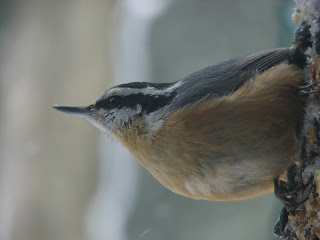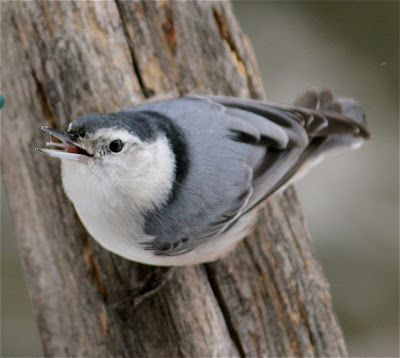 |
| White-breasted Nuthatch |
 |
| Red-breasted Nuthatch |
The collective term for nuthatches is “jar”. As in a jar of honey. Don’t know the origin of the term, will investigate.
At Protection Farm we have two species of Nuthatch- The Red-breasted (Sitta candensis) and the White-breasted (Sitta carolinensis)
-From Wikipedia: The Nuthatches are a genus, Sitta, of small passerine birds belonging to the family Sittadae. Characterized by large heads, short tails, and powerful bills and feet, nuthatches advertise their territory using loud, simple songs.”
-The name Nuthatch refers to the birds propensity of wedging an insect or seed in a crack and then going at it with the beak. There are 24 species currently recognized world wide with about 15 occurring in southern Asia. North America has 4 species
-The Brown-headed Nuthatch (Sitta pusillia) (southeast USA)
-Pygmy Nuthatch (Sitta pygmaea) Western North America from British Columbia to Mexico
-Red-breasted (Western and temperate North America)
-White-breasted (from southern Canada to Mexico)
There are nine subspecies of the White-breasted including two found in Mexico: S c mexicana found in Western Mexico, and S c kinneari, found in Guerrero and Oaxaca
Both the White Breasted and the Red-breasted Nuthatch occur year round at Protection Farm. The White-breasted nest and breed here for certain, the Red-breasted are migratory and subject to seasonal irruption.
 |
| Male |
White-breasted Nuthatch
Sitta carolinensis
Cornell, All About Birds: http://www.allaboutbirds.org/guide/White-breasted_Nuthatch/id
The White-breasted Nuthatch is a common year round resident at Protection Farm.
This small bird is the largest of North America’s nuthatches. It is non-migratory and seems to be paired with a mate year round. It can be very friendly and is extremely vocal. Its nasal yanking call is very familiar in every season around the woods and feeders. It is especially noticeable in winter as one of the few resident species of birds. Jajean calls these birds “Squeak-toys” because of both the call and the song.
White-breasted Nuthatches are active members of foraging flocks of chickadees, especially in wintertime. The flock behavior makes it easier for them to watch out for predators. They eat nuts and seeds in the winter, which makes them familiar winter feeder birds. In the summer they eat insects and larvae as well as seeds. They favor mature deciduous woodland.
Feeding behavior includes creeping up and down on tree trunks, and hanging upside down. They probe natural furrows and crevices for food. They do not use their tail feathers to lean on as woodpeckers do. These birds have evolved enlarged hind-toes to enable this behavior.
 |
| Male walking below Downy Woodpecker on Suet Feeder |
 |
| Male, note the shiny black cap |
 |
| Female-blue gray cap |
 |
| Enlarged hind toe for easier creeping and clasping |
The adult male has a shiny black crown and forehead. Its black eyes stand out against the white face. Its back is bluish-gray, its underbelly and undertail white and chestnut. The female and young birds are generally paler with a lead gray crown and forehead. the beak is slender, powerful, and sometimes slightly upturned.
 |
| female resting in pin cherry as male feeds |
 |
| Male |
 |
| Note the Chestnut colored under tail feathers |
Courting takes place in late January. According to Stokes, paired birds hang around together all year long and establish some independence starting in late autumn. By late January they begin to reestablish closeness and by early spring they are in “complete synchrony.” It is this late January time when you will notice that the male and female stay within 50 or so feet of each other. During this time the male will begin singing its song from the tops of the trees in early morning.
I noticed this singing this morning just at dawn. We had an unusual dawn today. It was a brilliant sunlit dawn and the temperatures were astoundingly cold. In nearby Franklinville, a mere 10 miles from Protection Farm, the temperatures hit -24 degrees F at 7am. Here it was -15. This was the coldest temperature in several years. And yet at dawn, I could hear a Nuthatch singing from the tree-tops. Theoretically the female will then come to the male and they will then go off and feed together. Also according to Stokes, one of the most prominent features of courtship is called “mate-feeding.” The male will get excited and find food and bring it to the female.
“Usually the female receives food with little or no display, but he males behavior may vary. He may run along a branch in a straight line to the female rather than the usual zig-zagging. Sometimes the food in the male’s beak is not accepted by the female and he will hide it in a crevice for later retrieval. Mate feeding increases in frequency as breeding, nest building, and hatching approach. Once the young hatch, this activity stops.”
Nest building and breeding take place in late March, April, and May. By late July the young have fledged and the adults return to more solitary behavior. Nests are typically built in natural tree cavities or abandoned woodpecker holes. Although populations remain fairly steady, habitat loss such as the removal of natural cavity structures is a threat. A single brood of between 5-9 is raised during the breeding season. The eggs are incubated for about 2 weeks.
Today, as the temperatures slowly rose into the 20’s there were at least three pairs of Nuthatches feeding. It was rare that more than one appeared on the suet, which is their favorite, at one time. Usually one would come in and feed and the other would wait just off in the nearby pin cherry trees. Occassionally a male would linger longer at the suet, and just sit there not feeding. The female would sit patiently for a while, but occasionally would fly in and make a bit of a racket chasing the male away. Occasionally two females would come to the feeding station at the same time. They would not feed adjacent to each other, but rather one would be at the suet, and one would be at one of the regular feeders.
Red Breasted Nuthatch
Sitta canadensis
Red Breasted Nuthatch
Sitta canadensis
This bird, common during the winter at Protection Farm is a migrant. It can breed in this area. Irruptions from the north including boreal areas occur seasonally due to conditions including availability of food. Not all populations migrate. According to Cornell some populations move south in great numbers in years when cone production is poor in their breeding grounds. This happens in approximately 2 year cycles. Some years these birds show up as far south as the Gulf Coast. It can winter through out most of the continental us (not Alaska). It also breeds in the Rockies, south to the Mexican border and along the Pacific Coast. They were once resident on the Mexican Isla Guadalupe, on the Pacific Coast but have been extirpated since 1971. Occasional vagrants have been recorded in the Mexican states of Sinaloa and Neuvo Leon.
These birds begin migration relatively early, sometimes in early July.
Cornell: http://www.allaboutbirds.org/guide/Red-breasted_Nuthatch/id?gclid=CIGr25nF1aYCFQRvbAodfC4sIw
They nest in trees, sometimes high in trees, sometimes only about 15 feet above the ground. They use resin around the entrance of the nest hole and on the inside. They may use their beaks or a piece of bark as an applicator. The resin keeps predators away. The Nuthatch avoids the resin by diving directly through the entrance hole.
Their call and song is very similar to the White-breasted Nuthatch. The call can be slightly more nasal, and the song can reach more of trill. Some say that the pitch is slightly higher than the White-breasted.
Red-breasted Nuthatches are smaller than the White-breasted. They have a distinct cap stripe and a black eye stripe. It is the only North American nuthatch with an eyestripe. Both sexes have dark gray backs and wings, and reddish underparts. The female has slightly paler underparts.
The male cap is starkly black and the female’s is slightly gray and offers little contrast to the back gray.
I have not noticed that these birds appear in pairs in the winter. Each bird seems to be solitary. They may begin to pair in March. Eggs are laid in April and May.
Food seems to be the same as the White-breasted. Nuts and insects. They are fond of conifer seeds.
 |
| Both Nuthatches tend to flock with Chickadees and other winter flock birds including Titmice, Junco's, and White-throats. |
 |
| This was my very first photo of a Nuthatch, taken in 2009 |








No comments:
Post a Comment